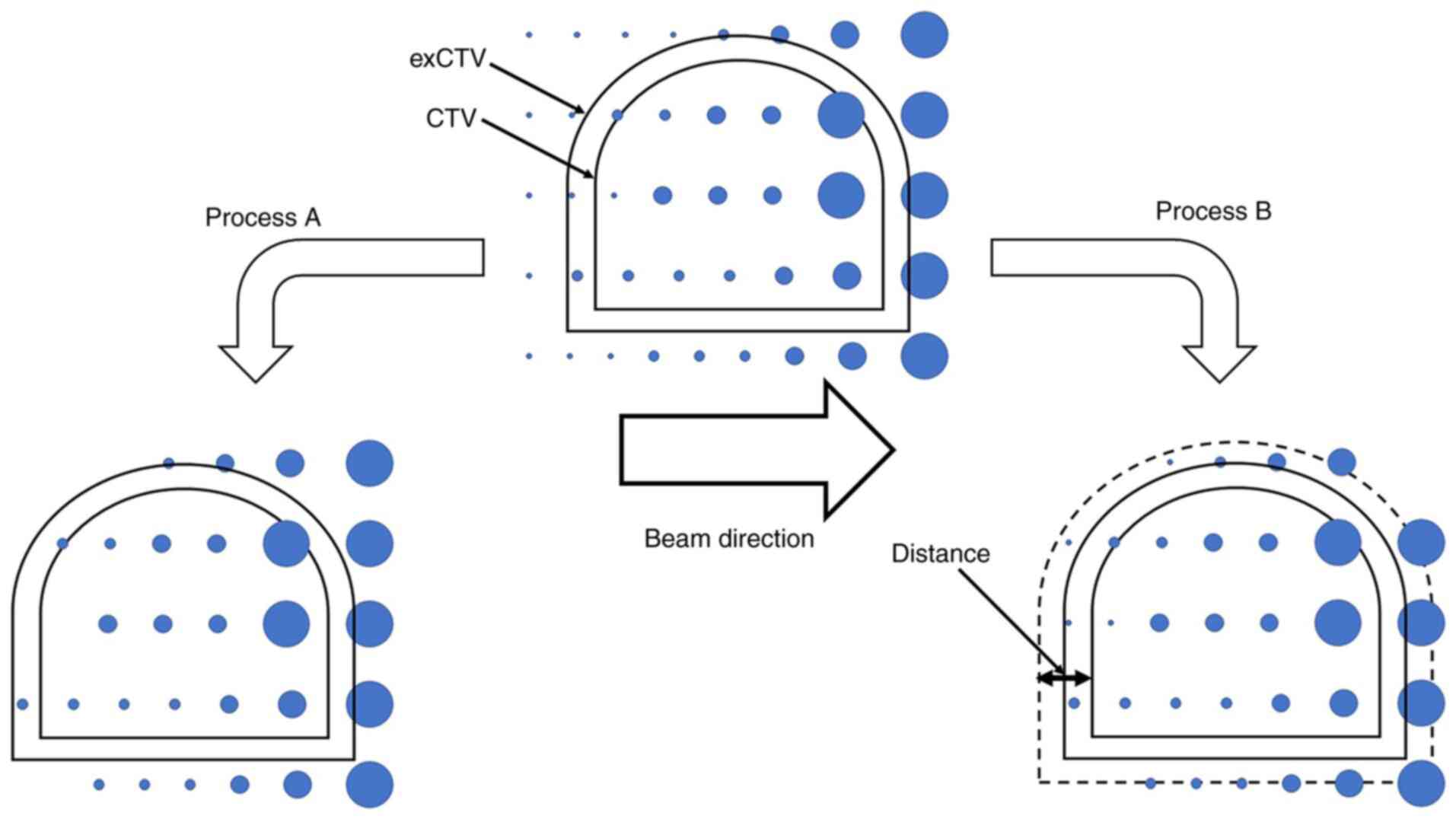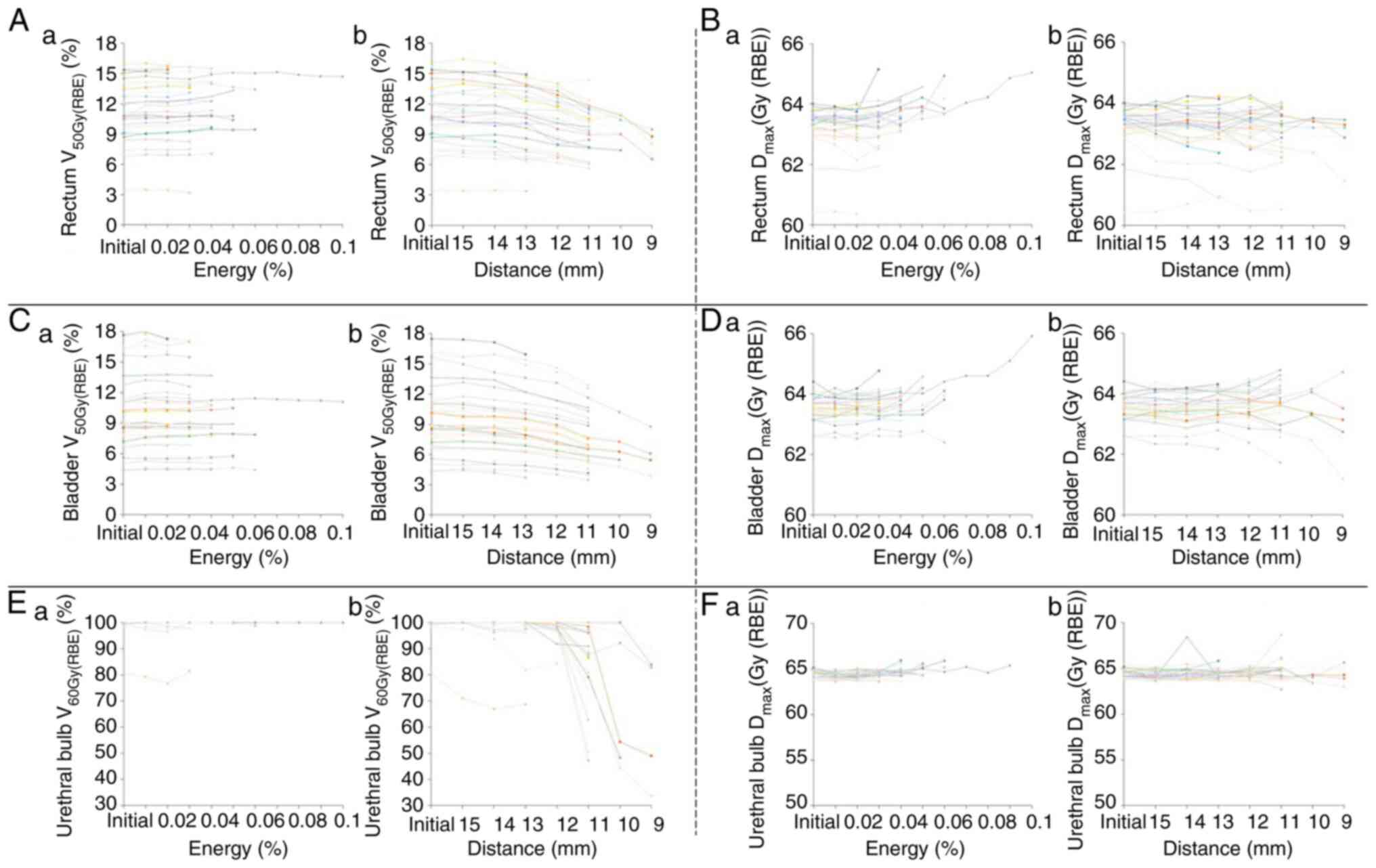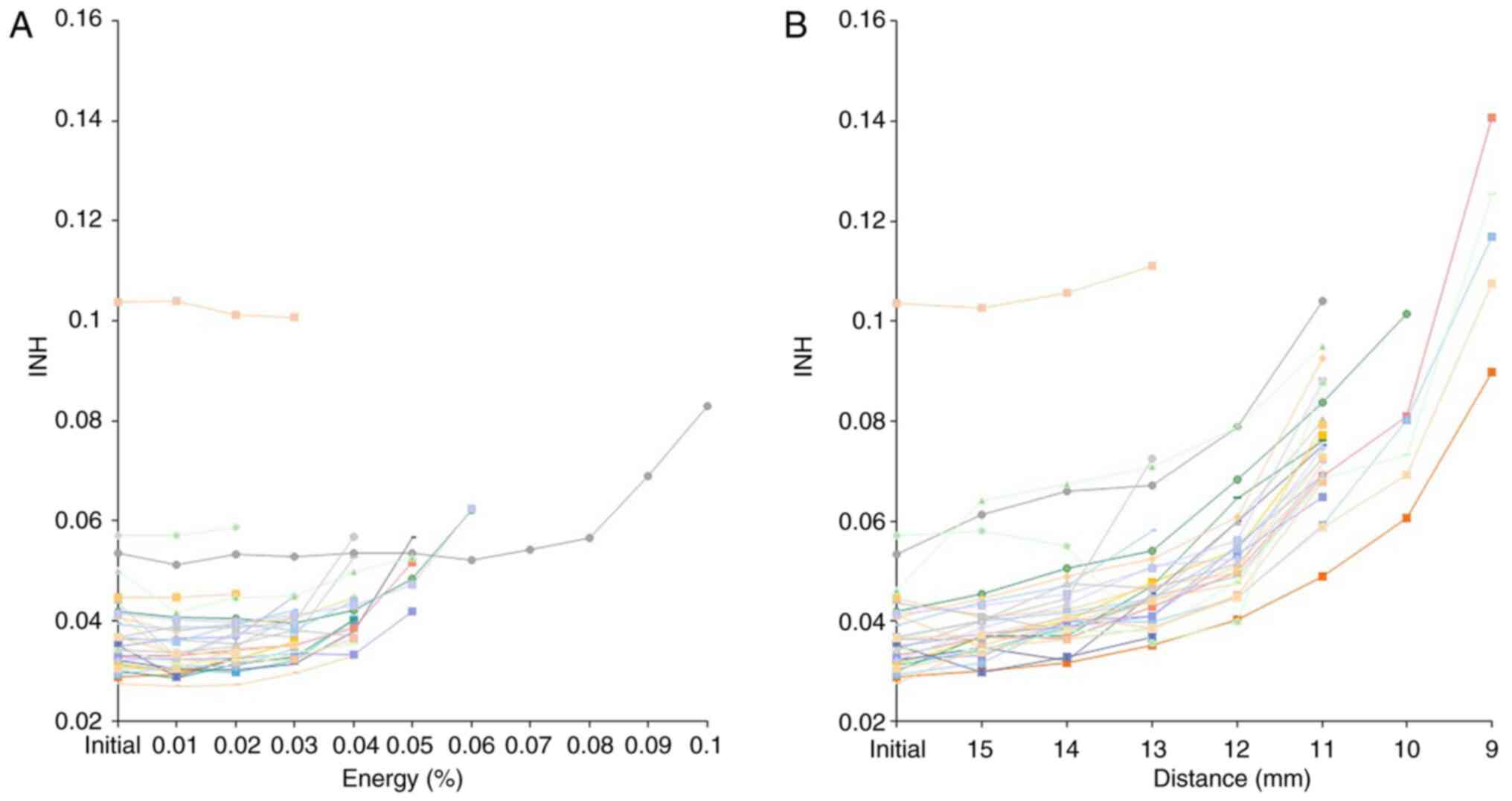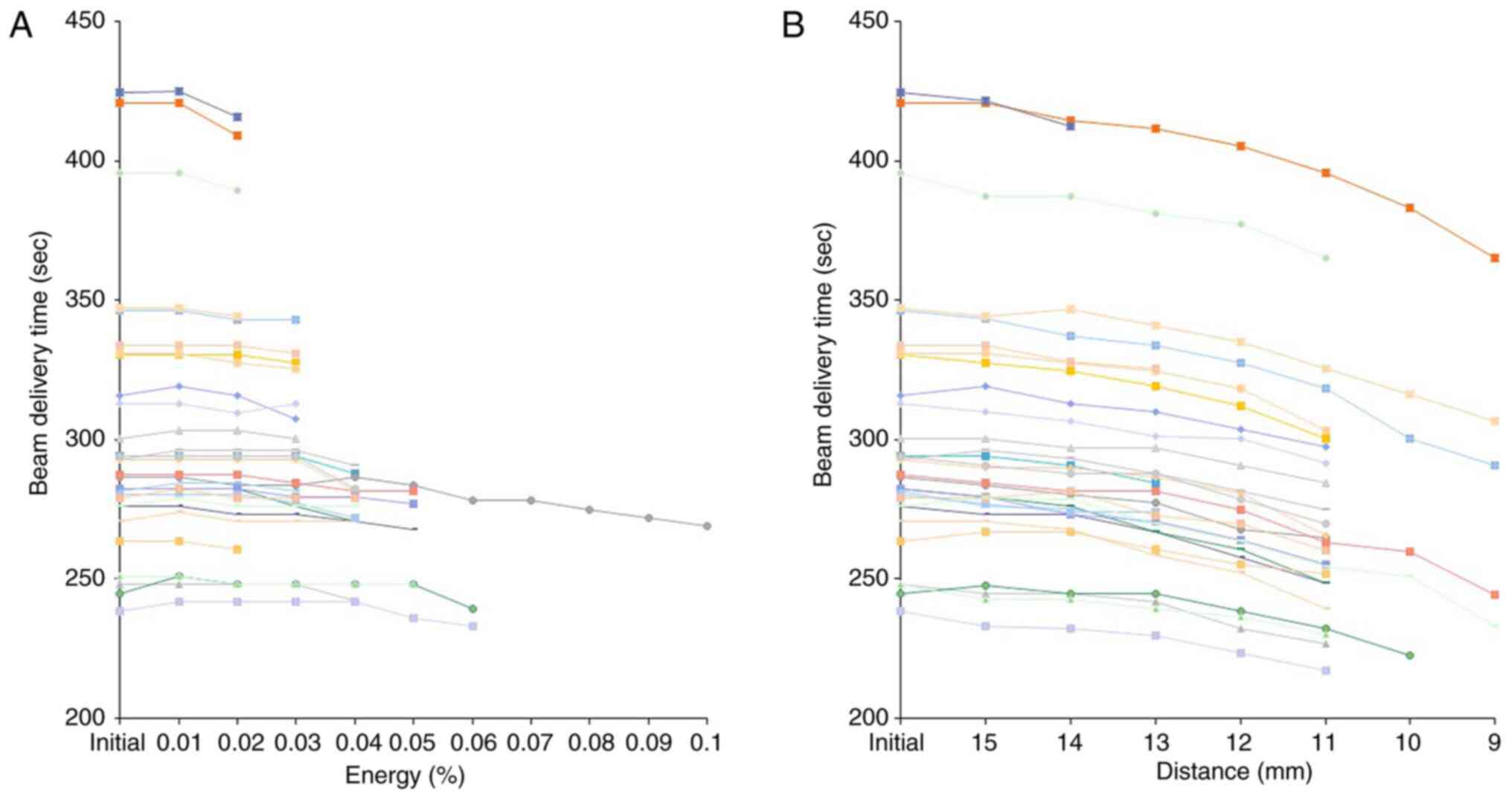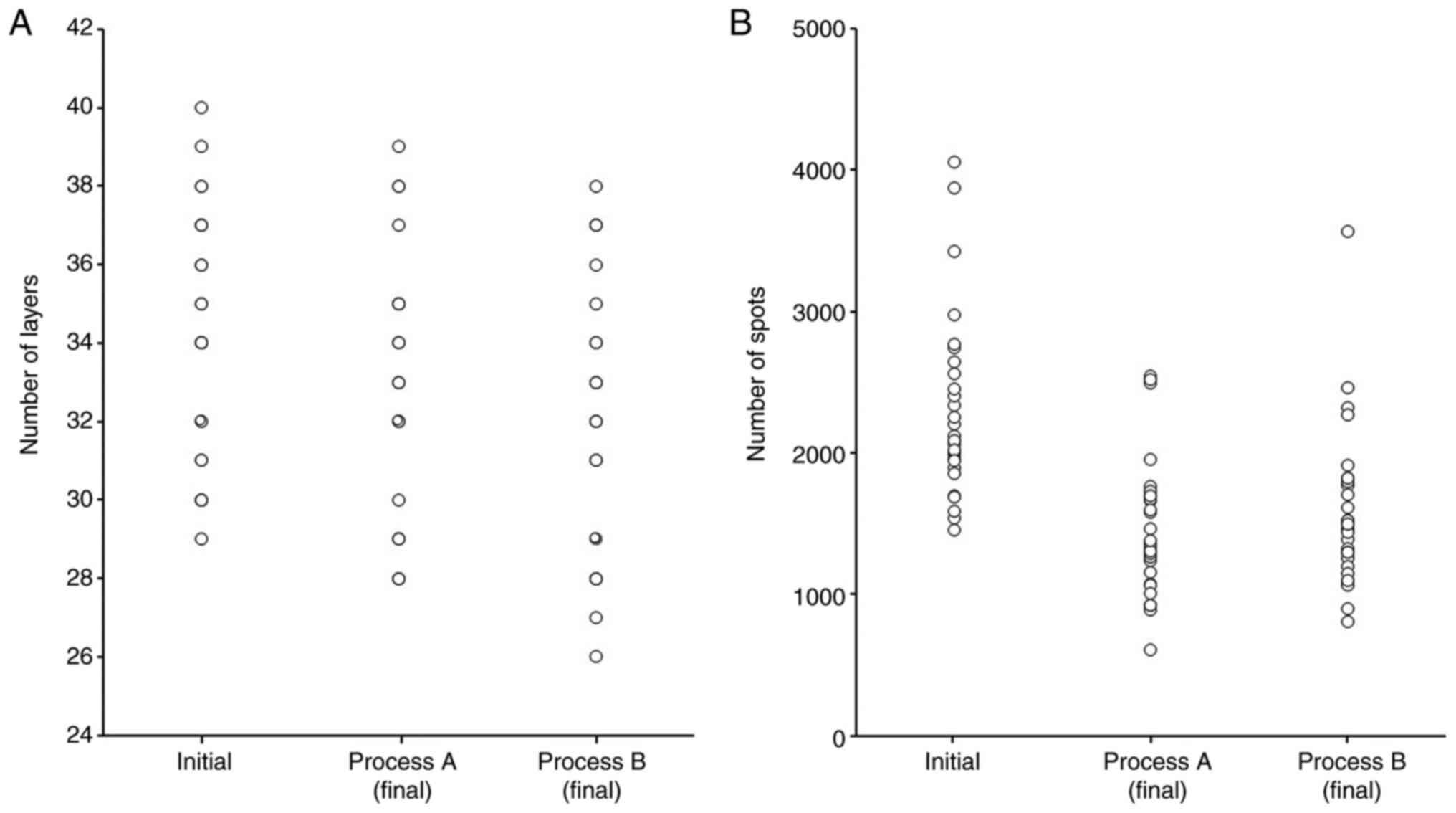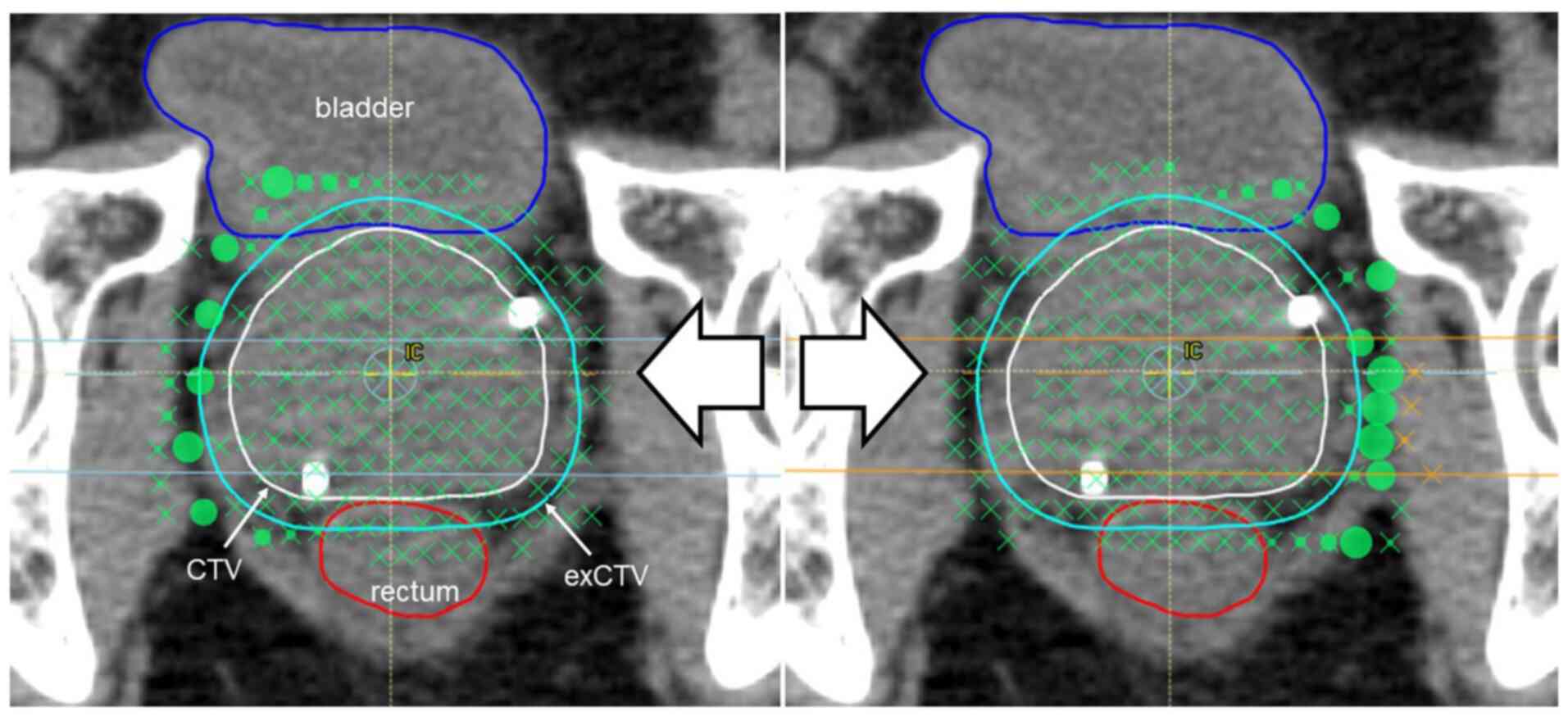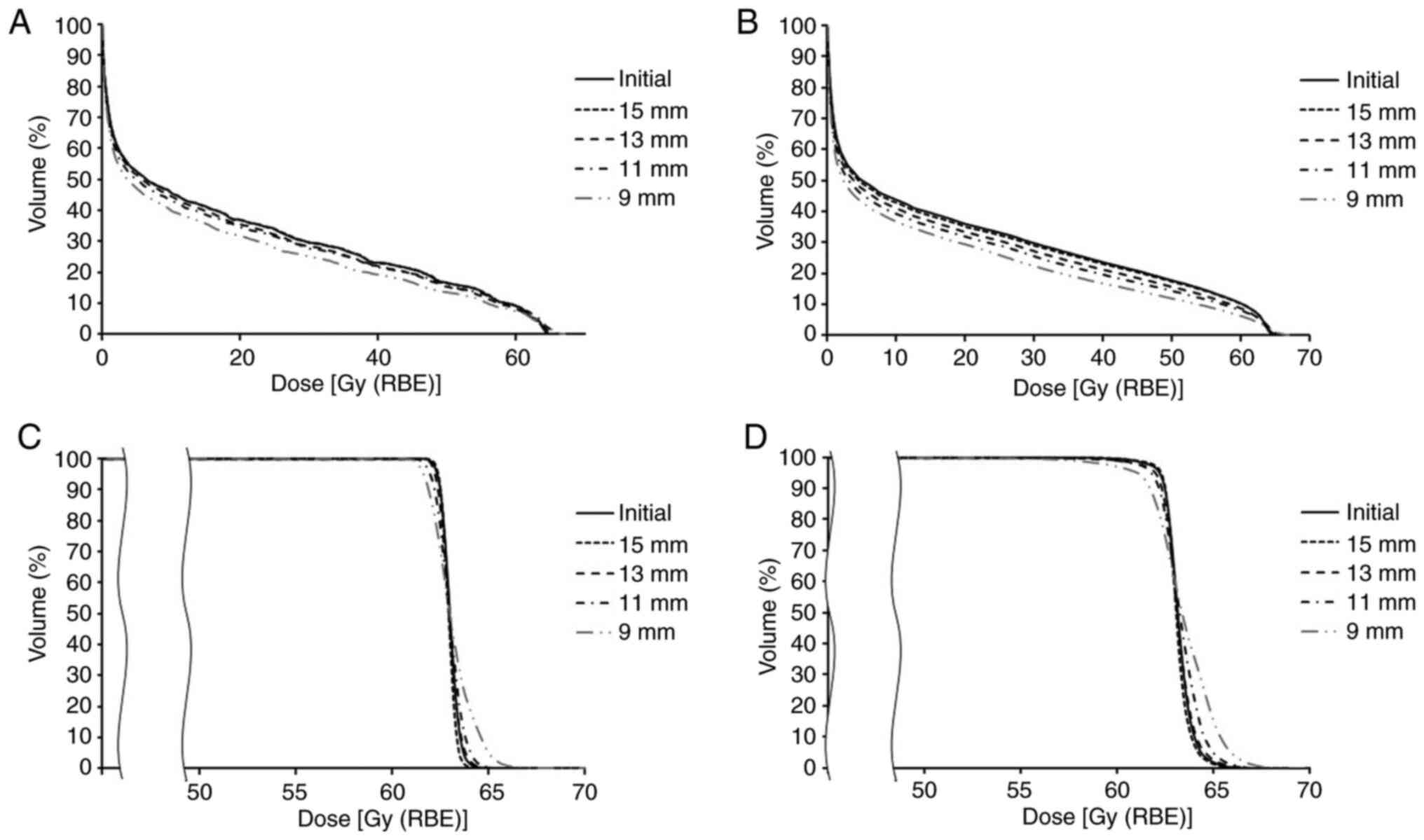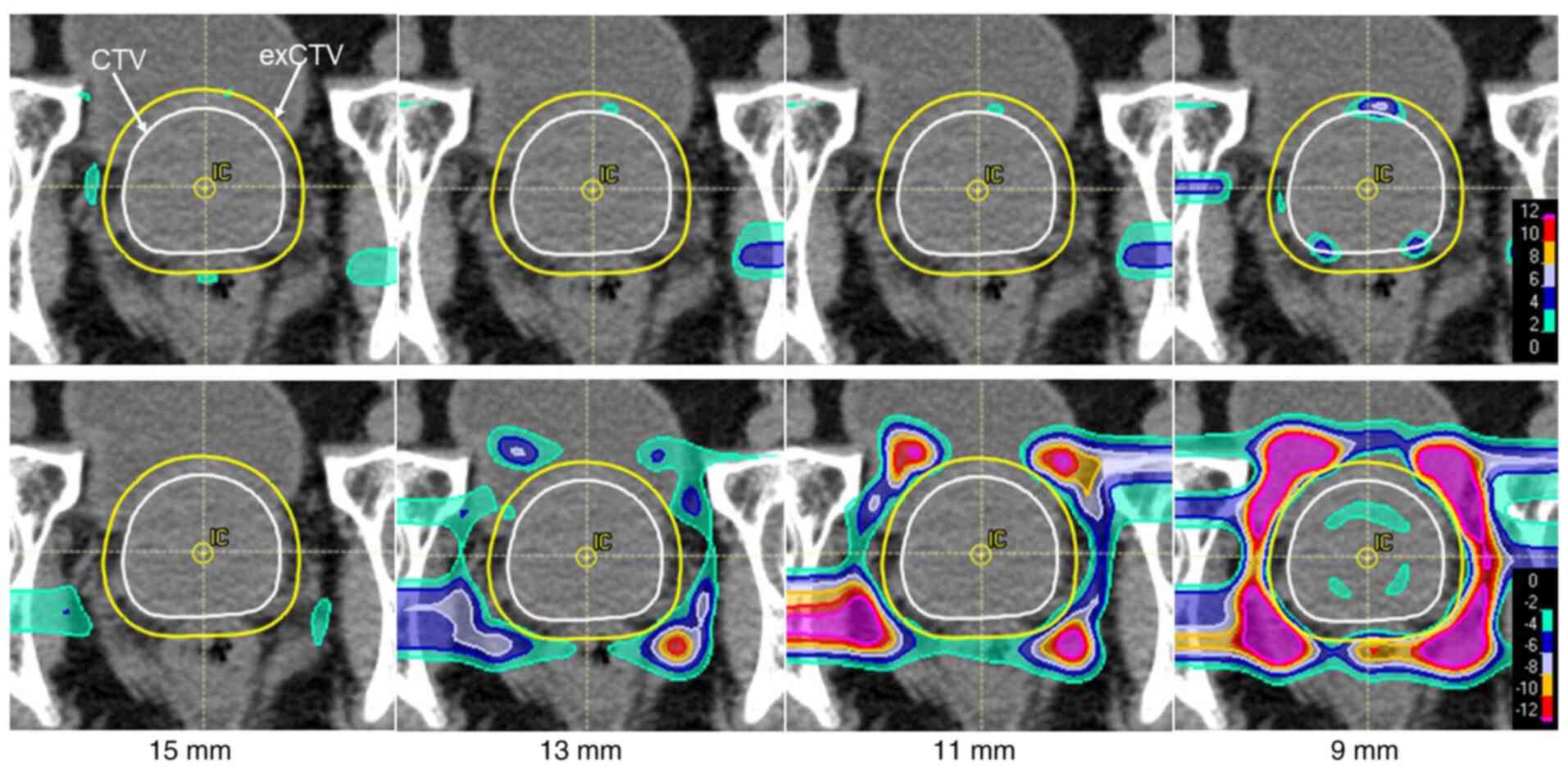|
1
|
Lawrence JH, Tobias CA, Born JL, Linfoot
JA, Kling RP and Gottschalk A: Alpha and proton heavy particles and
the bragg peak in therapy. Trans Am Clin Climatol Assoc.
75:111–116. 1964.PubMed/NCBI
|
|
2
|
Bortfeld T and Schlegel W: An analytical
approximation of depth-dose distributions for therapeutic proton
beams. Phys Med Biol. 41:1331–1339. 1996.PubMed/NCBI View Article : Google Scholar
|
|
3
|
Schulte RW, Slater JD, Rossi CJ Jr and
Slater JM: Value and perspectives of proton radiation therapy for
limited stage prostate cancer. Strahlenther Onkol. 176:3–8.
2000.PubMed/NCBI View Article : Google Scholar
|
|
4
|
Nihei K, Ogino T, Onozawa M, Onozawa M,
Murayama S, Fuji H, Murakami M and Hishikawa Y: Multi-institutional
phase II study of proton beam therapy for organ-confined prostate
cancer focusing on the incidence of late rectal toxicities. Int J
Radiat Oncol Biol Phys. 81:390–396. 2011.PubMed/NCBI View Article : Google Scholar
|
|
5
|
Royce TJ and Efstathiou JA: Proton therapy
for prostate cancer: A review of the rationale, evidence, and
current state. Urol Oncol. 37:628–636. 2019.PubMed/NCBI View Article : Google Scholar
|
|
6
|
Hyer DE, Hill PM, Wang D, Smith BR and
Flynn RT: A dynamic collimation system for penumbra reduction in
spot-scanning proton therapy: Proof of concept. Med Phys.
41(091701)2014.PubMed/NCBI View Article : Google Scholar
|
|
7
|
DeLaney TF: Proton therapy in the clinic.
Front Radiat Ther Oncol. 43:465–485. 2011.PubMed/NCBI View Article : Google Scholar
|
|
8
|
Bert C and Durante M: Motion in
radiotherapy: Particle therapy. Phys Med Biol. 56:R113–R144.
2011.PubMed/NCBI View Article : Google Scholar
|
|
9
|
Pugh TJ, Munsell MF, Choi S, Nguyen QN,
Mathai B, Zhu XR, Sahoo N, Gillin M, Johnson JL, Amos RA, et al:
Quality of life and toxicity from passively scattered and
spot-scanning proton beam therapy for localized prostate cancer.
Int J Radiat Oncol Biol Phys. 87:946–953. 2013.PubMed/NCBI View Article : Google Scholar
|
|
10
|
Widesott L, Pierelli A, Fiorino C, Lomax
AJ, Amichetti M, Cozzarini C, Soukup M, Schneider R, Hug E, Di
Muzio N, et al: Helical tomotherapy vs. intensity-modulated proton
therapy for whole pelvis irradiation in high-risk prostate cancer
patients: Dosimetric, normal tissue complication probability, and
generalized equivalent uniform dose analysis. Int J Radiat Oncol
Biol Phys. 80:1589–1600. 2011.PubMed/NCBI View Article : Google Scholar
|
|
11
|
van de Water S, Kraan AC, Breedveld S,
Schillemans W, Teguh DN, Kooy HM, Madden TM, Heijmen BJ and
Hoogeman MS: Improved efficiency of multi-criteria IMPT treatment
planning using iterative resampling of randomly placed pencil
beams. Phys Med Biol. 58:6969–6983. 2013.PubMed/NCBI View Article : Google Scholar
|
|
12
|
van de Water S, Safai S, Schippers JM,
Weber DC and Lomax AJ: Towards FLASH proton therapy: The impact of
treatment planning and machine characteristics on achievable dose
rates. Acta Oncol. 58:1463–1469. 2019.PubMed/NCBI View Article : Google Scholar
|
|
13
|
Wang D, Smith BR, Gelover E, Flynn RT and
Hyer DE: A method to select aperture margin in collimated spot
scanning proton therapy. Phys Med Biol. 60:N109–N119.
2015.PubMed/NCBI View Article : Google Scholar
|
|
14
|
Meier G, Leiser D, Besson R, Mayor A,
Safai S, Weber DC and Lomax AJ: Contour scanning for penumbra
improvement in pencil beam scanned proton therapy. Phys Med Biol.
62:2398–2416. 2017.PubMed/NCBI View Article : Google Scholar
|
|
15
|
Winterhalter C, Meier G, Oxley D, Weber
DC, Lomax AJ and Safai S: Contour scanning, multi-leaf collimation
and the combination thereof for proton pencil beam scanning. Phys
Med Biol. 64(015002)2018.PubMed/NCBI View Article : Google Scholar
|
|
16
|
Bues M, Newhauser WD, Titt U and Smith AR:
Therapeutic step and shoot proton beam spot-scanning with a
multi-leaf collimator: A Monte Carlo study. Radiat Prot Dosimetry.
115:164–169. 2005.PubMed/NCBI View Article : Google Scholar
|
|
17
|
Dowdell SJ, Clasie B, Depauw N, Metcalfe
P, Rosenfeld AB, Kooy HM, Flanz JB and Paganetti H: Monte Carlo
study of the potential reduction in out-of-field dose using a
patient-specific aperture in pencil beam scanning proton therapy.
Phys Med Biol. 57:2829–2842. 2012.PubMed/NCBI View Article : Google Scholar
|
|
18
|
Younkin JE, Bues M, Sio TT, Liu W, Ding X,
Keole SR, Stoker JB and Shen J: Multiple energy extraction reduces
beam delivery time for a synchrotron-based proton spot-scanning
system. Adv Radiat Oncol. 3:412–420. 2018.PubMed/NCBI View Article : Google Scholar
|
|
19
|
Zhang X, Penagaricano J, Narayanasamy G,
Corry P, Liu T, Sanjay M, Paudel N and Morrill S: Helical
tomotherapy to LINAC plan conversion utilizing RayStation Fallback
planning. J Appl Clin Med Phys. 18:178–185. 2017.PubMed/NCBI View Article : Google Scholar
|
|
20
|
International Commission on Radiation
Units & Measurements (ICRU): Prescribing, recording, and
reporting proton-beam therapy. ICRU 7: Report 78. ICRU, Bethesda,
MD, 2007.
|
|
21
|
Zhu XR, Poenisch F, Li H, Zhang X, Sahoo
N, Wu RY, Li X, Lee AK, Chang EL, Choi S, et al: A single-field
integrated boost treatment planning technique for spot scanning
proton therapy. Radiat Oncol. 9(202)2014.PubMed/NCBI View Article : Google Scholar
|
|
22
|
Kirk ML, Tang S, Zhai H, Vapiwala N,
Deville C, James P, Bekelman JE, Christodouleas JP, Tochner Z and
Both S: Comparison of prostate proton treatment planning technique,
interfraction robustness, and analysis of single-field treatment
feasibility. Pract Radiat Oncol. 5:99–105. 2015.PubMed/NCBI View Article : Google Scholar
|
|
23
|
Hou Z, Li G and Bai S: High dose versus
conventional dose in external beam radiotherapy of prostate cancer:
A meta-analysis of long-term follow-up. J Cancer Res Clin Oncol.
141:1063–1071. 2015.PubMed/NCBI View Article : Google Scholar
|
|
24
|
Jolnerovski M, Salleron J, Beckendorf V,
Peiffert D, Baumann AS, Bernier V, Huger S, Marchesi V and Chira C:
Intensity-modulated radiation therapy from 70 to 80Gy in prostate
cancer: Six-year outcomes and predictors of late toxicity. Radiat
Oncol. 12(99)2017.PubMed/NCBI View Article : Google Scholar
|
|
25
|
Thor M, Deasy JO, Paulus R, Robert Lee W,
Amin MB, Bruner DW, Low DA, Shah AB, Malone SC, Michalski JM, et
al: Tolerance doses for late adverse events after hypofractionated
radiotherapy for prostate cancer on trial NRG oncology/RTOG 0415.
Radiother Oncol. 135:19–24. 2019.PubMed/NCBI View Article : Google Scholar
|
|
26
|
Colaco RJ, Hoppe BS, Flampouri S, McKibben
BT, Henderson RH, Bryant C, Nichols RC, Mendenhall WM, Li Z, Su Z,
et al: Rectal toxicity after proton therapy for prostate cancer: An
analysis of outcomes of prospective studies conducted at the
university of Florida proton therapy institute. Int J Radiat Oncol
Biol Phys. 91:172–181. 2015.PubMed/NCBI View Article : Google Scholar
|
|
27
|
Boladeras A, Ferrer F, Navarro V, De Blas
R, Cunillera O, Mateo D, Gutierrez C, Martinez E, Villà S, Pera J,
et al: Association between EBRT dose volume histograms and quality
of life in prostate cancer patients. Rep Pract Oncol Radiother.
23:360–368. 2018.PubMed/NCBI View Article : Google Scholar
|
|
28
|
Shen J, Tryggestad E, Younkin JE, Keole
SR, Furutani KM, Kang Y, Herman MG and Bues M: Technical note:
Using experimentally determined proton spot scanning timing
parameters to accurately model beam delivery time. Med Phys.
44:5081–5088. 2017.PubMed/NCBI View
Article : Google Scholar
|
|
29
|
Rosas S, Belosi FM, Bizzocchi N, Böhlen T,
Zepter S, Morach P, Lomax AJ, Weber DC and Hrbacek J: Benchmarking
a commercial proton therapy solution: The paul scherrer institut
experience. Br J Radiol. 93(20190920)2020.PubMed/NCBI View Article : Google Scholar
|
|
30
|
Schippers JM and Lomax AJ: Emerging
technologies in proton therapy. Acta Oncol. 50:838–850.
2011.PubMed/NCBI View Article : Google Scholar
|
|
31
|
Engelsman M, Schwarz M and Dong L: Physics
controversies in proton therapy. Semin Radiat Oncol. 23:88–96.
2013.PubMed/NCBI View Article : Google Scholar
|
|
32
|
Mizushima K, Katagiri K, Iwata Y, Furukawa
T, Fujimoto T, Sato S, Hara Y, Shirai T and Noda K: Experimental
studies of systematic multiple-energy operation at HIMAC
synchrotron. Nucl Instrum Methods Phys Res Sec B. 331:243–247.
2014.
|
|
33
|
Hamstra DA, Mariados N, Sylvester J, Shah
D, Karsh L, Hudes R, Beyer D, Kurtzman S, Bogart J, His RA, et al:
Continued benefit to rectal separation for prostate radiation
therapy: Final results of a phase III trial. Int J Radiat Oncol
Biol Phys. 97:976–985. 2017.PubMed/NCBI View Article : Google Scholar
|
|
34
|
Karsh LI, Gross ET, Pieczonka CM, Aliotta
PJ, Skomra CJ, Ponsky LE, Nieh PT, Han M, Hamstra DA and Shore ND:
Absorbable hydrogel spacer use in prostate radiotherapy: A
comprehensive review of phase 3 clinical trial published data.
Urology. 115:39–44. 2018.PubMed/NCBI View Article : Google Scholar
|
|
35
|
Wei JT, Dunn RL, Litwin MS, Sandler HM and
Sanda MG: Development and validation of the expanded prostate
cancer index composite (EPIC) for comprehensive assessment of
health-related quality of life in men with prostate cancer.
Urology. 56:899–905. 2000.PubMed/NCBI View Article : Google Scholar
|















